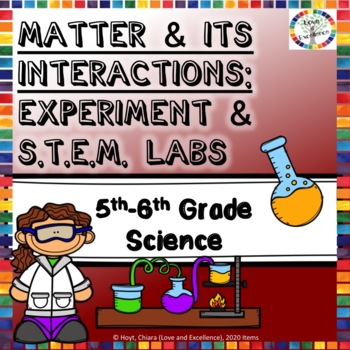STEM Lab NGSS Science Curriculum Activities 5th & 6th Grade: Matter Interactions
- PDF
Also included in
- Whether you are teaching 5th Grade NGSS Science or 6th Grade NGSS Science in a classroom, homeschool, or distance learning setting, this BUNDLE resource includes 10 full lessons, 2 STEM challenges, a Review & Quiz Pack, a Practice Unit Test, and Full Unit Assessment, all containing everything aPrice $31.85Original Price $45.50Save $13.65
Description
This resource contains two 5th and 6th grade level STEM activities and challenges that can be completed in the classroom or at home. Explicit directions as well as wide-ranging flexibility make these STEM activities perfect for traditional Science classrooms or for distance learning.
The first STEM activity allows learners to engage in an experiment that compares the water solubility of three common household substances. The basic experimental process student work page gives students explicitly listed materials, directions, and a graph to complete. The student work template guides students through research, as well as requires them to use learned experimental design concepts such as variables, control groups, failure point analysis, and conclusion analysis and application, in order to complete the lab report.
The second STEM project allows students to engage in the engineering design process in order to successfully make a drawing "come to life" by detaching from the drawing surface while staying completely in tact. Using only items from a given list, students are instructed to carry out, revise, and analyze the success of multiple design solutions to this challenge, based on a set of given conditions and criteria. The student work template guides students through initial designs, revisions, cost-benefit analysis, reflections, and more, in order to help them arrive at a successful design solution.
A student design and planning packet for each activity is provided to ensure that students carefully navigate the experimental and engineering design processes during these STEM challenges. Students of widely varying ability levels in 5th and 6th grade will see success with these projects, as they are easily differentiated and modified.
Resource Contents Include:
- Scientific Experiment Lab: Comparing Solubility Across Three Substances
- Teacher/Student Instructions
- Student Design Process Work Template
- Engineering Design Challenge: Drawings Come To Life!
- Challenge Information
- Teacher Instructions
- Student Instructions
- Student Engineering Design Process Work Template
*Please leave feedback to earn credit toward future TpT purchases. I value and respond to all feedback!*
You May Also Like:
- STEM Distance Learning Activities 5th & 6th Gr Experimental & Engineering Design
- 5th & 6th Grade Science Distance Learning: Solubility Lesson Materials
*Don't Miss A Thing! Follow Love and Excellence so you never miss a sale or new product!*






